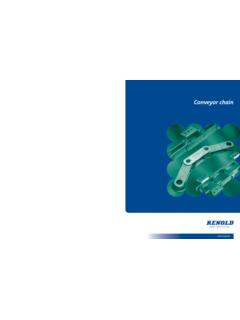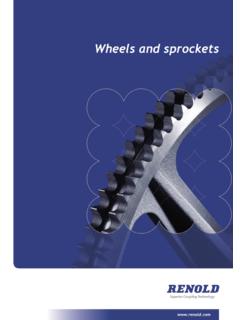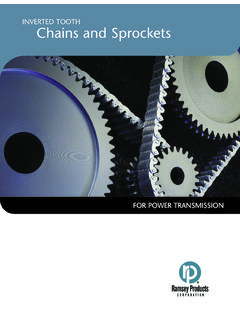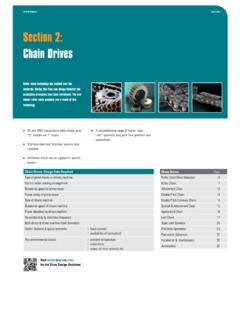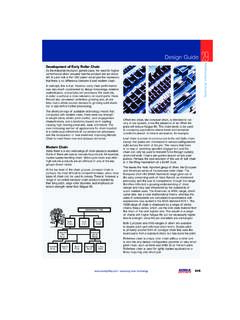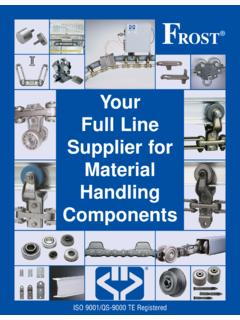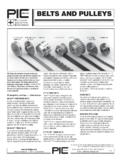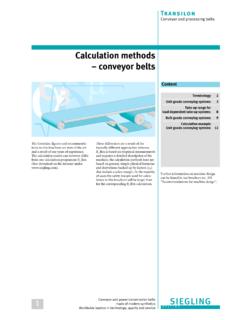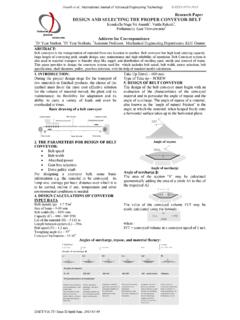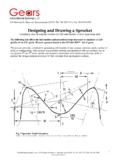Transcription of Designer Guide Specification Guideline - Interbelts.com
1 Renold Roller chain Catalogue I91 Section 3 Designer Guide Specification Guideline92 IRenold Roller chain CatalogueSection 3 Renold chain Designer GuideDevelopment of Early Roller/Bush ChainAs the industrial revolution gained pace, theneed for higher performance chain ensuredthat the product did not stand still. A quicklook at the 1880 patent would give the impression that there is no difference between it and modern concept, this is true. However, early chainperformance was very much constrained bydesign knowledge, material sophistication andproduction processes.
2 For example, in order toachieve a close tolerance on round parts, HansRenold also pioneered centreless grinding andat one time had a whole section devoted togrinding cold drawn bar to size before shortcomings of available technologymeant that, compared with modern chain ,there were low strength to weight ratios, erratic pitch control, poor engagement characteristics and a tendency toward pointloading, causing high bearing pressures, wearand failure. The ever increasing number ofapplications for chain resulted in a continuousrefinement of our production processes andthe introduction of heat treatment, improvingRenold chain to meet these new and ChainThere is today a very wide range of chain products available.
3 Some of these are speciallow volume products, for example nuclearwaste handling chain . Other high volume products such as motorcycle chain are an offshoot of one of the key groups shown the top level of the chain groups, conveyorchain is perhaps the most difficult to compartmentalise, since most types of chaincan be used to convey. There is, however, arange of so called conveyor chain products typified by its long pitch, large roller diameterand emphasis on tensile strength rather thanfatigue life. Cranked link chain , like conveyor chain , isintended to run only at low speeds, since thepresence of a cranked plate will reduce fatiguelife.
4 This chain tends to be used in conveyingapplications where harsh environmental conditions prevail, in mineral excavation for chain is similar in construction to the oldGalle chain , except that plates are interleavedin various configurations right across the widthof the pin. This means that there is no way ofproviding sprocket engagement and the chaincan only be used to transmit force throughsuitably anchored ends. Chains are guidedaround simple plain pulleys. Perhaps the bestexample of the use of leaf chain is in the liftingmechanism of a fork lift leaves the most important group of chain , the European and American series oftransmission chain .
5 The European (from the old British Standard) range, grew out of theearly pioneering work of Hans Renold, as mentioned above, and the size of componentsthrough the range therefore reflected a growingunderstanding of chain design and probablywas influenced by the availability of stockmaterial sizes. The American or ANSI range,which came later, has a clear mathematicaltheme, whereby the sizes of components arecalculated in accordance with expressions nowquoted in the ANSI standard It shouldalso be mentioned here that the ANSI range ofchain is shadowed by a range of similar chains,but using the side plate material from thechain of the next highest size.
6 This results in arange of chains with higher fatigue life but notnecessarily higher tensile strength, since thepin diameters are Roller chain Catalogue I93 Section 3 Renold chain Designer GuideBoth European and ANSI ranges of chain areavailable in double pitch and bush chain pitch is primarily another form of conveyor chain using the round parts from a standard chain , but having twice the chain is simply roller chain without aroller and is also the only design configurationpossible on very small pitch chain , such as4mm and ANSI 25 or 1/4 inch pitch.
7 Bush chainis used for lightly loaded applications or thoserequiring only direct chain has features incorporated whichenable demanding applications to be tackledwith ease. These include high wear and fatigueresistance and transmission efficiency ofaround 98%. chain is also now manufactured in multiplestrands joined together by a common pin, givingmore scope for increased power transmissionin restricted space. The range of products nowavailable with alternative materials, specialcoatings, endless varieties of attachments, hollow bearing pins and anti-backbend, toname just a few, give scope for the widestportfolio of design solutions with improvements to factory applied greases and better understanding ofapplicational techniques.
8 Designers can nowspecify transmission chain with PerformanceRenold chain products that are dimensionallyin line with the ISO standard far exceed the stated ISO minimum tensile strengthrequirements. However Renold does not consider breaking load to be a key indicator ofperformance because it ignores the principalfactors of wear and fatigue. In these areas,Renold products are designed to produce thebest possible results and independent testingproves this catalogue, where the ISO breaking loadis quoted, it should be noted that we are statingthat the Renold product conforms to the ISOminimum standard.
9 Independent test resultsshow that the minimum (many companiesquote averages) breaking loads were far inexcess of the ISO the quoted breaking load is notdescribed as being the ISO minimum, the product has no relevant ISO standard. In this case, the breaking loads quoted are theminimum performance of a chain is governed by anumber of key factors. The tensile strength isthe most obvious since this is the means bywhich a chain installation is roughly , since a chain is constructed fromsteel, the yield strength of which is around65% of the ultimate tensile strength, any loadabove this limit will cause some permanentdeformation to take place with consequentrapid to the s-n curve below shows that at loads below this 65% line.
10 Finite life may beexpected and at subsequent reductions in loadthe expected life increases until the fatigueendurance limit is reached at around 8,000, below 10,000,000 will result in infinitefatigue life. The failure mode will then becomewear related which is far safer, since a con-trolled monitor of chain extension can takeplace at suitable planned intervals. In practice,if a load ratio of tensile strength to maximumworking load of 8:1 is chosen, then theendurance limit will not normally be consideration of the expected maximumworking loads should be given since these areoften much higher than the Designer maythink!
